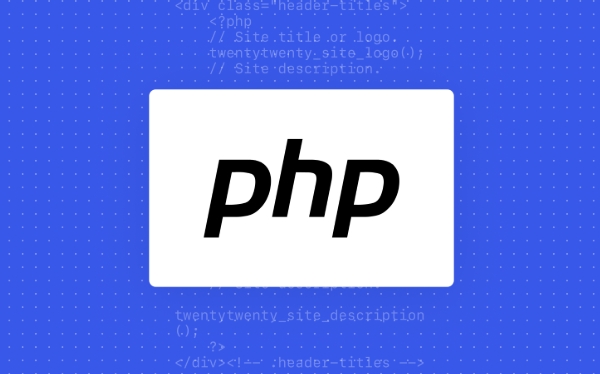The Power and Peril of Reference Assignment (`=&`) in PHP
Jul 30, 2025 am 05:39 AMPHP's =& operator creates variable references, so that multiple variables point to the same data, and modifying one will affect the other; 2. Its legal uses include returning references from a function, processing legacy code and specific variable operations; 3. However, it is easy to cause problems such as not releasing references after loops, unexpected side effects, and debugging difficulties; 4. In modern PHP, objects are passed by reference handles by default, and arrays and strings are copied on write-time, and performance optimization no longer requires manual references; 5. The best practice is to avoid using =& in ordinary assignments, and unset references in time after loops, and only use parameter references when necessary and document descriptions; 6. In most cases, safer and clear object-oriented design should be preferred, and =& should be used with caution only when a very small number of clear needs.

PHP's reference assignment operator ( =& ) is one of those features that give you a lot of power—but with that power comes the potential for confusion, bugs, and hard-to-debug issues if used carefully. While references can be useful in specific scenarios, they behave very differently from regular variable assignment and require a solid understanding to use safely.

Let's break down what =& really does, where it can help, and why it's often best avoided.
What =& Actually Does
In PHP, the = operator assigns by value , meaning a copy of the data is made:

$a = 10; $b = $a; // $b gets a copy of $a's value $b = 20; // $a remains 10
But when you use =& , you're creating a reference —two variable names that point to the same underlying data:
$a = 10; $b =& $a; // $b now references $a $b = 20; // $a also becomes 20 echo $a; // Outputs: 20
Now, $a and $b are effectively aliases of each other. Any change through one affects the other.

? Important: This is not the same as object assignment in modern PHP. Since PHP 5, objects are assigned by reference semantics (technically, via object handles), but that's automatic and doesn't require
=&.
Legitimate Uses of =& (Rare but Real)
Although its risks, there are a few cases where =& was historically useful:
1. Returning References from Functions
If you need a function to return a reference to a variable (eg, for modifying a global or static value), you can do:
function &getCounter() {
static $count = 0;
return $count;
}
$counter =& getCounter();
$counter ;
echo getCounter(); // Outputs: 1This allows direct modification of the static variable through the returned reference.
2. Working with Legacy Code or APIs
Some older PHP frameworks or extensions (like early versions of PEAR) used =& for performance or design reasons, especially before PHP's engine optimized value copying (copy-on-write). You might still encounter it in old codebases.
3. Swapping or Manipulating Variables Directly
function swap(&$a, &$b) {
$temp = $a;
$a = $b;
$b = $temp;
} Though here, we're using pass-by-reference in parameters ( &$a ), not =& . The =& operator is for assignment, not parameter declaration.
The Perils of Misusing =&
Although its utility in edge cases, =& comes with several pitfalls.
? Confusing Behavior in Loops
A classic gotcha involves foreach and references:
$array = [1, 2, 3];
foreach ($array as &$value) {
$value *= 2;
}
// $value is still a reference to the last element!
$value = 100; // This changes the last element of $array! Even after the loop, $value remains a reference. If you reuse $value later, you might accidentally modify the array. Always unset the reference:
unset($value); // Break the reference
? Unexpected Side Effects
Because references link variables, changes in one place can ripple unexpectedly:
$original = "hello"; $temp =& $original; // Later in code... $temp = "modified"; echo $original; // "modified" — maybe not what you expected!
This makes code harder to reason about, especially when references are passed around or used in complex scopes.
? Debugging Headaches
When variables are linked via references, var_dump() or debug_backtrace() won't clearly show that two variables are bound together. Tracking down why a variable changed “on its own” can be frustrating.
Modern PHP: You Probably Don't Need =&
Thanks to improvements in PHP's engine (especially copy-on-write semantics and object handle semantics), most performance reasons for using =& have disappeared.
Objects are already handled by reference-like semantics:
$obj1 = new stdClass(); $obj2 = $obj1; // No need for =& — they refer to the same object $obj2->prop = 'test'; echo $obj1->prop; // 'test'
Arrays and strings are copied only when modified (copy-on-write), so assigning them doesn't cause performance issues.
- ? Avoid
=&in regular variable assignment. It's rarely needed. - ? Unset references after
foreachloops to prevent lingering side effects. - ? Use pass-by-reference in function parameters (
function foo(&$var)) only when necessary (eg, modifying caller's variable). - ? Document clearly when references are used—future maintainers (including you) will thank you.
- ? Prefer object-oriented patterns over manual reference management.
In short: avoid =& unless you have a very specific, well-justified reason.
Best Practices
If you must use references, follow these guidelines:
Final Thoughts
The =& operator is a low-level tool that exposes a sharp edge. While it gives fine-grained control over variable identity, it often leads to fragile, hard-to-follow code. In most modern PHP applications, it's obsolete.
Use it sparingly, understand it deeply, and always ask: Is there a cleaner, safer way?
Most of the time, the answer is yes.
The above is the detailed content of The Power and Peril of Reference Assignment (`=&`) in PHP. For more information, please follow other related articles on the PHP Chinese website!

Hot AI Tools

Undress AI Tool
Undress images for free

Undresser.AI Undress
AI-powered app for creating realistic nude photos

AI Clothes Remover
Online AI tool for removing clothes from photos.

Clothoff.io
AI clothes remover

Video Face Swap
Swap faces in any video effortlessly with our completely free AI face swap tool!

Hot Article

Hot Tools

Notepad++7.3.1
Easy-to-use and free code editor

SublimeText3 Chinese version
Chinese version, very easy to use

Zend Studio 13.0.1
Powerful PHP integrated development environment

Dreamweaver CS6
Visual web development tools

SublimeText3 Mac version
God-level code editing software (SublimeText3)

Hot Topics
 The Spaceship Operator (``): Simplifying Complex Sorting Logic
Jul 29, 2025 am 05:02 AM
The Spaceship Operator (``): Simplifying Complex Sorting Logic
Jul 29, 2025 am 05:02 AM
Thespaceshipoperator()inPHPreturns-1,0,or1basedonwhethertheleftoperandislessthan,equalto,orgreaterthantherightoperand,makingitidealforsortingcallbacks.2.Itsimplifiesnumericandstringcomparisons,eliminatingverboseif-elselogicinusort,uasort,anduksort.3.
 Beyond Merging: A Comprehensive Guide to PHP's Array Operators
Jul 29, 2025 am 01:45 AM
Beyond Merging: A Comprehensive Guide to PHP's Array Operators
Jul 29, 2025 am 01:45 AM
Theunionoperator( )combinesarraysbypreservingkeysandkeepingtheleftarray'svaluesonkeyconflicts,makingitidealforsettingdefaults;2.Looseequality(==)checksifarrayshavethesamekey-valuepairsregardlessoforder,whilestrictidentity(===)requiresmatchingkeys,val
 Demystifying PHP's Type Juggling: A Deep Dive into `==` vs. `===`
Jul 31, 2025 pm 12:45 PM
Demystifying PHP's Type Juggling: A Deep Dive into `==` vs. `===`
Jul 31, 2025 pm 12:45 PM
Using === instead of == is the key to avoiding the PHP type conversion trap, because === compares values and types at the same time, and == performs type conversion to lead to unexpected results. 1.==The conversion will be automatically performed when the types are different. For example, 'hello' is converted to 0, so 0=='hello' is true; 2.====The value and type are required to be the same, avoiding such problems; 3. When dealing with strpos() return value or distinguishing between false, 0, '', null, ===; 4. Although == can be used for user input comparison and other scenarios, explicit type conversion should be given priority and ===; 5. The best practice is to use === by default, avoid implicit conversion rules that rely on == to ensure that the code behavior is consistent and reliable.
 The Power and Peril of Reference Assignment (`=&`) in PHP
Jul 30, 2025 am 05:39 AM
The Power and Peril of Reference Assignment (`=&`) in PHP
Jul 30, 2025 am 05:39 AM
The =& operator of PHP creates variable references, so that multiple variables point to the same data, and modifying one will affect the other; 2. Its legal uses include returning references from a function, processing legacy code and specific variable operations; 3. However, it is easy to cause problems such as not releasing references after a loop, unexpected side effects, and debugging difficulties; 4. In modern PHP, objects are passed by reference handles by default, and arrays and strings are copied on write-time, and performance optimization no longer requires manual reference; 5. The best practice is to avoid using =& in ordinary assignments, and unset references in time after a loop, and only use parameter references when necessary and document descriptions; 6. In most cases, safer and clear object-oriented design should be preferred, and =& is only used when a very small number of clear needs.
 The Subtle Art of Pre-increment vs. Post-increment in PHP Expressions
Jul 29, 2025 am 04:44 AM
The Subtle Art of Pre-increment vs. Post-increment in PHP Expressions
Jul 29, 2025 am 04:44 AM
Pre-increment( $i)incrementsthevariablefirstandreturnsthenewvalue,whilepost-increment($i )returnsthecurrentvaluebeforeincrementing.2.Whenusedinexpressionslikearrayaccess,thistimingdifferenceaffectswhichvalueisaccessed,leadingtopotentialoff-by-oneer
 Short-Circuiting and Precedence Traps: `&&`/`||` vs. `and`/`or`
Jul 30, 2025 am 05:34 AM
Short-Circuiting and Precedence Traps: `&&`/`||` vs. `and`/`or`
Jul 30, 2025 am 05:34 AM
Inlanguagesthatsupportboth,&&/||havehigherprecedencethanand/or,sousingthemwithassignmentcanleadtounexpectedresults;1.Use&&/||forbooleanlogicinexpressionstoavoidprecedenceissues;2.Reserveand/orforcontrolflowduetotheirlowprecedence;3.Al
 A Deep Dive into the Combined Assignment Operators for Cleaner Code
Jul 30, 2025 am 03:26 AM
A Deep Dive into the Combined Assignment Operators for Cleaner Code
Jul 30, 2025 am 03:26 AM
Combinedassignmentoperatorslike =,-=,and=makecodecleanerbyreducingrepetitionandimprovingreadability.1.Theyeliminateredundantvariablereassignment,asinx =1insteadofx=x 1,reducingerrorsandverbosity.2.Theyenhanceclaritybysignalingin-placeupdates,makingop
 Mastering Polymorphism: A Practical Guide to the `instanceof` Type Operator
Jul 30, 2025 am 01:40 AM
Mastering Polymorphism: A Practical Guide to the `instanceof` Type Operator
Jul 30, 2025 am 01:40 AM
instanceofinTypeScriptisatypeguardthatnarrowsobjecttypesbasedonclassmembership,enablingsaferandmoreexpressivepolymorphiccode.1.Itchecksifanobjectisaninstanceofaclassandinformsthecompilertonarrowthetypewithinconditionalblocks,eliminatingtheneedfortype






